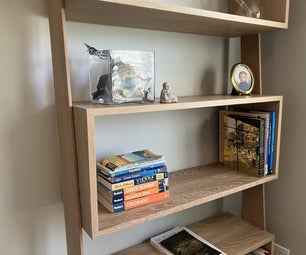Introduction: Ten Green Modular Shelving: Shelving and Tables Using Glass Bottles
Ten Green is a modular shelving system, constructed simply from local recyclates.
This prototype was built with the Coach House Trust in Glasgow, using bottles from their recycling centre, and wood from the maintenance of their own sites. You can use any found timber, and adapt the dimensions to suit the wood you are working with.
Some examples are for sale at our shop here.
Design is released under a share alike/attribution CC license by Zero-waste Design.
This prototype was built with the Coach House Trust in Glasgow, using bottles from their recycling centre, and wood from the maintenance of their own sites. You can use any found timber, and adapt the dimensions to suit the wood you are working with.
Some examples are for sale at our shop here.
Design is released under a share alike/attribution CC license by Zero-waste Design.
Attachments
Step 1: Get Your Bits N Bobs.
For one module you will need:
Four bottles. All the same brand/height/shape preferable. Wash them thoroughly in hot soapy water.
Two hook and eye strainers / turnbuckles as they are sometimes called. I used the smallest I could find, which are 14mm OD at the buckle and 5mm OD at the threads. Such as these from Screwfix.
Two planks of wood, prepared as shown in the .pdf template - careful! there are two different hole diameters, and if you are leaving one rough edge as I did here, make sure you take your measurements from the straight datum edge.
*REVISION* I would now NOT drill the holes in the lower shelf (the 30mm ones) all the way through, but drill them from below to half depth, using a flat bit. They will then rest on the tops of the bottles of the module below, rather than allowing the necks to pass striaght through as was the case in this prototype. (See discussion in comments)
Screw in the cup hooks halfway between the holes on either side, as shown. Depending on the height of your bottles, you may need some ess hooks too to help the strainer reach between the upper and lower hooks.
Four bottles. All the same brand/height/shape preferable. Wash them thoroughly in hot soapy water.
Two hook and eye strainers / turnbuckles as they are sometimes called. I used the smallest I could find, which are 14mm OD at the buckle and 5mm OD at the threads. Such as these from Screwfix.
Two planks of wood, prepared as shown in the .pdf template - careful! there are two different hole diameters, and if you are leaving one rough edge as I did here, make sure you take your measurements from the straight datum edge.
*REVISION* I would now NOT drill the holes in the lower shelf (the 30mm ones) all the way through, but drill them from below to half depth, using a flat bit. They will then rest on the tops of the bottles of the module below, rather than allowing the necks to pass striaght through as was the case in this prototype. (See discussion in comments)
Screw in the cup hooks halfway between the holes on either side, as shown. Depending on the height of your bottles, you may need some ess hooks too to help the strainer reach between the upper and lower hooks.
Step 2: Place the Bottles and Top Shelf
Place the bottles concentrically over the holes of the lower shelf. Then carefully lower on top the upper shelf, allowing the necks of the bottles to pass through the 46mm holes in the upper shelf. Allow the shelf to rest on the necks of the bottles. Then by hand adjust the bottoms of the bottles so that they sit flush with the lower shelf.
Step 3: Tense Up!
Attach the hook and eye strainers and ess hooks if needed, between the opposing hooks. Tighten up thoroughly.
Step 4: Assemble Into a Larger Unit
Make as many modules as you need, of whatever sizes you require. As long as the bottles are of the same height, and your holes are drilled precisely, you can stack the modules on top of each other
Step 5: Experiment!
This is an epilogue to suggest some other Ten Green-type furniture that I have worked on since: A kitchen shelving unit, which is more of a kit really, and two coffee tables which were made to commission/to suit specific bits of wood!
The tables are just the same as the shelving modules but flipped upside down, and without holes in the shelf at the base of the bottles (the table top).
More info at www.zero-waste.co.uk.
I would be up for trialling the new 'Collaborate' feature of instructables with someone on this project. Message me if you're interested.
The tables are just the same as the shelving modules but flipped upside down, and without holes in the shelf at the base of the bottles (the table top).
More info at www.zero-waste.co.uk.
I would be up for trialling the new 'Collaborate' feature of instructables with someone on this project. Message me if you're interested.
Participated in the
The Instructables Book Contest











